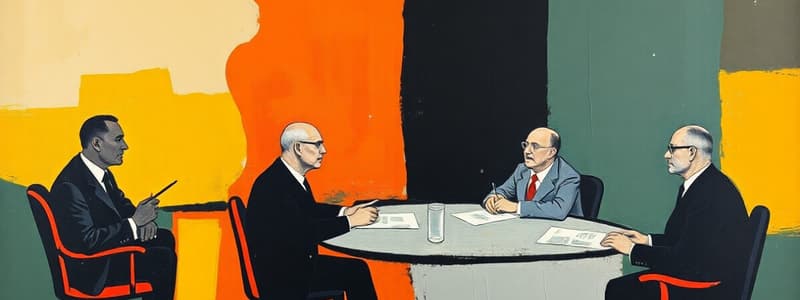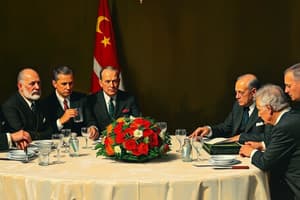Podcast
Questions and Answers
Which of the following was NOT a direct consequence of World War II?
Which of the following was NOT a direct consequence of World War II?
- Significant political and economic decline in Europe.
- Widespread destruction of infrastructure and farmland across Europe.
- The emergence of the United States as a leading global power.
- The immediate collapse of the Soviet Union due to war-related economic strain. (correct)
What was the primary goal of the Nuremberg Trials?
What was the primary goal of the Nuremberg Trials?
- To offer amnesty to all former Nazi party members in exchange for information.
- To establish a new German government free from Allied influence.
- To fairly judge and punish the Nazi leaders for their war crimes and human rights abuses. (correct)
- To rebuild the German city of Nuremberg as a symbol of peace.
What was the main purpose of the Atlantic Charter, signed by Franklin D. Roosevelt and Winston Churchill in 1941?
What was the main purpose of the Atlantic Charter, signed by Franklin D. Roosevelt and Winston Churchill in 1941?
- To divide Europe into American and British spheres of influence.
- To formally declare war on Germany and its allies.
- To coordinate war actions and establish principles for a post-war world. (correct)
- To negotiate a separate peace treaty with Japan.
At which conference did Roosevelt, Churchill, and Stalin first meet to discuss strategies for the war and the establishment of the United Nations?
At which conference did Roosevelt, Churchill, and Stalin first meet to discuss strategies for the war and the establishment of the United Nations?
Which of the following topics was addressed at the Yalta Conference in 1945?
Which of the following topics was addressed at the Yalta Conference in 1945?
How did the United States benefit from not having battles fought on its territory during World War II?
How did the United States benefit from not having battles fought on its territory during World War II?
What significant decision impacting the war in Asia was made at the Cairo Conference in 1943?
What significant decision impacting the war in Asia was made at the Cairo Conference in 1943?
What was the significance of the Allies' decision, made at the Casablanca Conference, regarding the Axis powers?
What was the significance of the Allies' decision, made at the Casablanca Conference, regarding the Axis powers?
What key decision was made at the Potsdam Conference regarding Germany and Austria?
What key decision was made at the Potsdam Conference regarding Germany and Austria?
How did the Potsdam Conference contribute to the emergence of the Cold War?
How did the Potsdam Conference contribute to the emergence of the Cold War?
What was the primary objective of the United Nations (UN) when it was founded in 1945?
What was the primary objective of the United Nations (UN) when it was founded in 1945?
Which factor significantly limited the UN's effectiveness in addressing conflicts during the Cold War?
Which factor significantly limited the UN's effectiveness in addressing conflicts during the Cold War?
What was the key ideological difference between the two superpowers, the United States and the Soviet Union, during the Cold War?
What was the key ideological difference between the two superpowers, the United States and the Soviet Union, during the Cold War?
How did the United States and the Soviet Union establish their spheres of influence after World War II?
How did the United States and the Soviet Union establish their spheres of influence after World War II?
What was the primary purpose of establishing military alliances like NATO and the Warsaw Pact during the Cold War?
What was the primary purpose of establishing military alliances like NATO and the Warsaw Pact during the Cold War?
During the Cold War, the United States and the Soviet Union developed a strategic system of threat and defense. What was this system based on?
During the Cold War, the United States and the Soviet Union developed a strategic system of threat and defense. What was this system based on?
What was the primary military strategy employed by Germany in the early stages of World War II that initially led to significant territorial gains?
What was the primary military strategy employed by Germany in the early stages of World War II that initially led to significant territorial gains?
What were the key factors contributing to the Soviet's successful mobilization and eventual counter-offensive against the German invasion during the 'Great Patriotic War'?
What were the key factors contributing to the Soviet's successful mobilization and eventual counter-offensive against the German invasion during the 'Great Patriotic War'?
Which of the following best describes the strategic importance of the Battle of Stalingrad in the context of World War II?
Which of the following best describes the strategic importance of the Battle of Stalingrad in the context of World War II?
What was the significance of the Allied forces' landing in Casablanca, Morocco, in November 1942?
What was the significance of the Allied forces' landing in Casablanca, Morocco, in November 1942?
How did the Allied victory at the Battle of El Alamein impact the course of World War II?
How did the Allied victory at the Battle of El Alamein impact the course of World War II?
How did the Allied invasion of Sicily in 1943 contribute to the progression of World War II?
How did the Allied invasion of Sicily in 1943 contribute to the progression of World War II?
What was the primary objective of the Normandy Invasion, and why was it considered a critical turning point in World War II?
What was the primary objective of the Normandy Invasion, and why was it considered a critical turning point in World War II?
What was the significance of the Red Army's advance through Eastern Europe in the summer of 1944?
What was the significance of the Red Army's advance through Eastern Europe in the summer of 1944?
Flashcards
Pearl Harbor Attack
Pearl Harbor Attack
Surprise attack by Japan on the US naval fleet, leading to US entry into WWII.
Blitzkrieg
Blitzkrieg
German military tactic using aviation and motorized columns for rapid attacks.
Great Patriotic War
Great Patriotic War
Soviet mobilization marked by tactical improvements, industrial relocation, and resistance against Nazi invaders.
Battle of Stalingrad
Battle of Stalingrad
Signup and view all the flashcards
Casablanca Landing (1942)
Casablanca Landing (1942)
Signup and view all the flashcards
Battle of El Alamein
Battle of El Alamein
Signup and view all the flashcards
Sicily Landing (1943)
Sicily Landing (1943)
Signup and view all the flashcards
Normandy Invasion (D-Day)
Normandy Invasion (D-Day)
Signup and view all the flashcards
Material losses of WWII
Material losses of WWII
Signup and view all the flashcards
USA's Post-WWII Status
USA's Post-WWII Status
Signup and view all the flashcards
Nürnberg Trials
Nürnberg Trials
Signup and view all the flashcards
Atlantic Charter
Atlantic Charter
Signup and view all the flashcards
Casablanca Conference
Casablanca Conference
Signup and view all the flashcards
Cairo Conference
Cairo Conference
Signup and view all the flashcards
Tehrān Conference
Tehrān Conference
Signup and view all the flashcards
Yalta Conference
Yalta Conference
Signup and view all the flashcards
Potsdam Conference
Potsdam Conference
Signup and view all the flashcards
United Nations (UN)
United Nations (UN)
Signup and view all the flashcards
Universal Declaration of Human Rights
Universal Declaration of Human Rights
Signup and view all the flashcards
Security Council
Security Council
Signup and view all the flashcards
Cold War
Cold War
Signup and view all the flashcards
Soviet Bloc
Soviet Bloc
Signup and view all the flashcards
"The Free World"
"The Free World"
Signup and view all the flashcards
NATO
NATO
Signup and view all the flashcards




